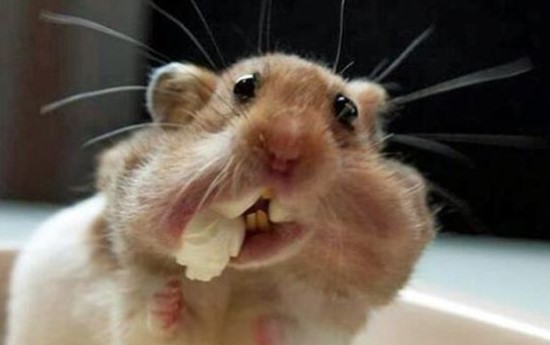Not all pets have dental problems, but most rodents do, unfortunately. Hamsters are no exception. Their teeth grow throughout life, and if they do not wear off naturally, they need to be trimmed.
Constantly Growing Incisors

Many herbivorous animals, such as rabbits, chinchillas, and hamsters, have teeth that grow constantly, so caring for them means cutting them regularly. If you compare the incisors of rodents with the teeth of cats, dogs, and humans, you will notice that they are much longer. Natural grinding occurs when hamsters chew hay, special toys, and other objects – in this case, the length of the teeth is regulated in a natural way. But some individuals have to regularly trim their teeth due to a combination of genetic and individual characteristics.
Too Long Hamster Teeth
It is very easy to tell if your hamster’s front teeth (incisors) have grown too much. When the incisors reach a certain length, they begin to curl up and protrude between the lips. Teeth begin to get stuck in food and toys, and the saddest thing is that they can grow into the gums and palate. The molars (chewing teeth located behind the incisors) in hamsters are also quite long, but very rarely bend and interfere with the animals. However, this is sometimes difficult to determine without a special mirror. One of the signs of overly long molars is that the animals have excessive salivation, it becomes difficult for them to chew and swallow food.
Undercutting Your Hamster’s Incisors
If done correctly, trimming is painless for the hamster. Since they have a very small mouth, it is dangerous to use the drill (although it has been successfully used for a similar procedure in rabbits and chinchillas). Surgical scissors or nail clippers can be used for this purpose. It is very important not to overdo it and not to cut your teeth too short: this will be extremely painful for the animal. It is best to seek this service from a veterinarian: it is usually inexpensive.
Undercutting Molars
It is generally more difficult to trim molars than incisors, but fortunately, this is much less necessary. Only a veterinarian can determine the need for undercutting molars. The molars are trimmed with a special surgical instrument. If the hamster allows it to climb into its mouth, the process is very quick and easy. There is a small chance of injury, but this is rare. If your pet is not given, anesthesia may be applied. This method is ideal for the treatment of molars, but naturally, the cost of anesthesia will not please every owner.
Owners of hamsters and other rodents with constantly growing teeth should be aware of the potential difficulties associated with their pet’s oral hygiene. Without proper care, overgrown teeth can lead to serious injury, anorexia, and even death from the inability to chew and swallow food. Fortunately, the problem is easily solved with regular teeth trimming.

